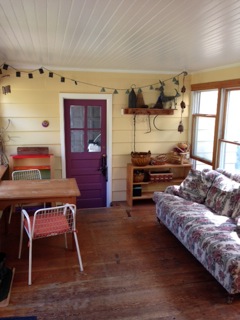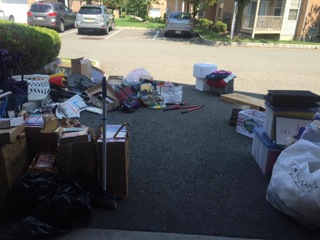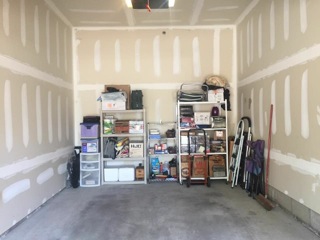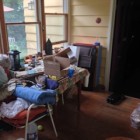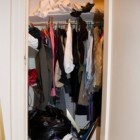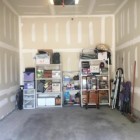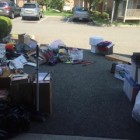The lazy summer days of August are a perfect time to tackle some of those organizing and de-cluttering projects you’ve been meaning to get to, before the hustle and bustle of back-to-school descends.
Not sure where to begin? Read on.
Professional organizer Christine Muccigrosso, owner of The Clutter Clinic and Diane Thomson, a member of the National Association of Professional Organizers and owner of Creative Organizing, shared some of their strategies for addressing those common pitfalls that plague even those most conscientious homeowner.
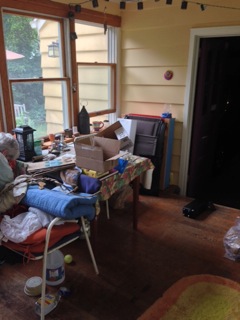
Before: A corner that needs some straightening out, courtesy of Christine Muccigrosso of The Clutter Clinic.
Before you beat yourself up about your living space not appearing magazine cover worthy or impromptu guest-ready, relax, says Thomson. Organizing is not about being “neat and perfect,” she says. Rather, it’s about setting up your environment so it functions for your lifestyle.
Having a system that allows you to manage the things you interact with and the information that flows in and out of your life efficiently is more important than stressing about your home looking picture perfect, she advises.
The following are Thomson and Muccigrosso’s suggestions for literally getting your house in order:
1. Develop a System That Works for You
The number one culprit when it comes to failing to stay organized is mail, Thomson says. Not only does so much enter our homes each day, much of it demands our time, energy, and attention, which we don’t often possess by the evening when we’re confronted with a stack of paper.
Thomson says rather than allowing it to pile up, which can have dire consequences when it comes to missed appointments or payments, set up a system that allows you to deal with it in minutes. The organizer says she opens all her mail at her desk, making it easier for her to sort and separate. Bills are placed in a slot, while catalogs and junk mail go into a recycle bin. Credit card offers and anything bearing personal information are placed in the shredder that sits beneath her desk while important papers get filed.
“I feel it’s important for me not to have a backlog,” says Thomson, who adds that allowing piles to accumulate can lead to homeowners eventually shoving them all into a bag that gets tossed into a closet before company arrives. “Going through my mail takes me three minutes a day because I have a system in place.”
2. Stop the Cycle
Whether it’s catalogs or donation requests that are clogging your mailbox and ultimately your living spaces, it might be worth spending a few moments to curtail the flow of these into your home, Thomson says. Websites like Catalog Choice.org or DMA choice.org are opt-out services that allow you to weed out much of the mail you don’t ever need or want to see.
3. Start with the End in Mind
For those who have certain parts of the home that are problem areas, Muccigrosso says figure out where those are and visualize the end goal.
“Pick an area that is bugging you the most to start — or that area that will need to be sorted before you can get to the area that’s bugging you the most,” says Muccigrosso. “Sort into broad categories: trash, donate, recycle, live here, leave here. Clearly label them with post-its. Start in one corner and work your way around the area. Don’t run to put items away in other areas until the very end; it’s a big time sucker.”
4. Touch It Once
While you’re working through the sorting, Muccigrosso advises adopting a “touch it once” mantra.
“Pick it up and decide where it’s going immediately,” she says. “The more times you touch it before you decide what to do with it, the more time that item has just sucked from your life.”
5. Under 2 Just Do
Thomson suggests that if the task is one that can be completed in under two minutes, take care of it straight away. For example, if you receive something in the mail that requires a quick phone call just do it rather than place that paper reminder in a pile to be dealt with later.
6. Don’t Fall Into the Container Trap
Marketers are excellent at making shiny new storage bins look like the answer to your organizing woes, Muccigrosso says. But in reality, you really just own too many things and need to purge and then categorize what’s left before even thinking about storage.
“A hundred products won’t work if they sit in the corner with stuff piled up on them,” she says. “You have to put in the work first and sort through to see what you have. Then, and only then should you figure out the best way to keep it organized. I always tell my clients not to buy a thing until we are finished.”
While sorting, Muccigrosso says she and her clients typically find plenty of items to repurpose.
“I reuse items like mason jars, food containers, tins, and shoe boxes,” she says. “It doesn’t have to be pretty and new unless the client wants that. That free Amazon shipping box can hold all your electrical cords just as well as that $10 paisley cloth bin from Bed, Bath & Beyond.”
7. Build Time Into Your Day
Thomson points out that as we grow up we’re taught to take care of things like hygiene and meal preparation but no one ever advises us to schedule in time to take care of mail and other papers that enter our home.
“We need to shift to recognize that in our day we need to have ‘CEO moments,’” she says “That’s the time when you take on the job of saying, ‘Let me figure out my home and follow up on tasks.”
8. Be Realistic
Even the most enthusiastic organizer can quickly feel overwhelmed when sorting through mountains of belongings. Thomson, who worked for many years in the mental health field, explains that items stir up a range of emotions, making them hard to part with.
“We’re very good at consuming, at bringing things in,” she says, “but we’re not a nation of letting go.”
Muccigrosso suggests working in set periods of time — 30 minutes to two hours — to avoid frustration. Hire a babysitter if you have to, she says, as “toddlers and clutter busting don’t mix.”
Speaking of the kids, Thomson, will offer a Student Organization Skills for Middle School Student class at the SOM Adult School on October 13 and 20. The organizer says being realistic about what to expect from children is important as well. For example, if you simply tell a pre-teen to clean his room but he doesn’t necessarily know where the items belong or a workable system (see tip #1) isn’t in place, chances are he won’t get too far.
Even once efficient systems are established, it’s important to remember that needs shift and being flexible is key.
“People don’t realize that organizing isn’t a ‘one and done’ project, it’s an organic process that will need to live and change just like people’s lives,” Muccigrosso says. “I am constantly re-organizing areas in my own house as things come in and go out and work flow changes. It’s the only way to keep things sane. Just because you got that linen closet organized today, doesn’t mean you won’t have to do it again for 20 years.”
Also, don’t be afraid to tweak newly-organized areas, she says, as sometimes it takes a few days of living with the redesign to determine if the method is truly working for you. If not, change it up.
“Real Simple and those kinds of magazine make people feel bad like fashion magazines make women feel bad. Again, remember, your home doesn’t need to be neat or perfect to be organized,” Thomson reiterates.
For more information, visit The Clutter Clinic’s website or Creative Organizing’s website.

